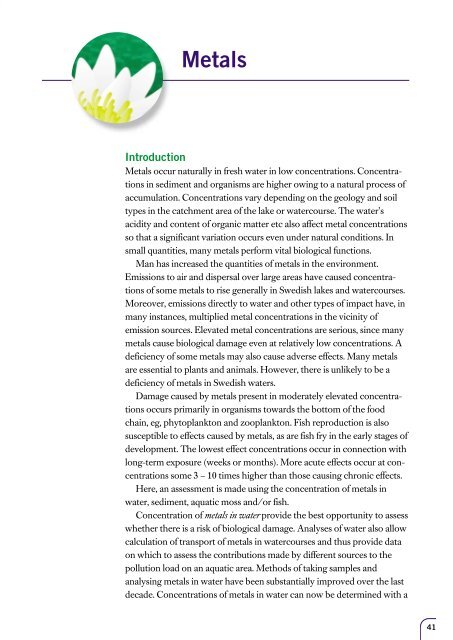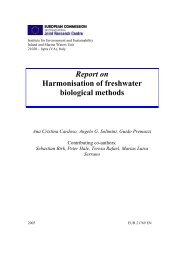Lakes and Watercourses
Lakes and Watercourses
Lakes and Watercourses
You also want an ePaper? Increase the reach of your titles
YUMPU automatically turns print PDFs into web optimized ePapers that Google loves.
Metals<br />
Introduction<br />
Metals occur naturally in fresh water in low concentrations. Concentrations<br />
in sediment <strong>and</strong> organisms are higher owing to a natural process of<br />
accumulation. Concentrations vary depending on the geology <strong>and</strong> soil<br />
types in the catchment area of the lake or watercourse. The water’s<br />
acidity <strong>and</strong> content of organic matter etc also affect metal concentrations<br />
so that a significant variation occurs even under natural conditions. In<br />
small quantities, many metals perform vital biological functions.<br />
Man has increased the quantities of metals in the environment.<br />
Emissions to air <strong>and</strong> dispersal over large areas have caused concentrations<br />
of some metals to rise generally in Swedish lakes <strong>and</strong> watercourses.<br />
Moreover, emissions directly to water <strong>and</strong> other types of impact have, in<br />
many instances, multiplied metal concentrations in the vicinity of<br />
emission sources. Elevated metal concentrations are serious, since many<br />
metals cause biological damage even at relatively low concentrations. A<br />
deficiency of some metals may also cause adverse effects. Many metals<br />
are essential to plants <strong>and</strong> animals. However, there is unlikely to be a<br />
deficiency of metals in Swedish waters.<br />
Damage caused by metals present in moderately elevated concentrations<br />
occurs primarily in organisms towards the bottom of the food<br />
chain, eg, phytoplankton <strong>and</strong> zooplankton. Fish reproduction is also<br />
susceptible to effects caused by metals, as are fish fry in the early stages of<br />
development. The lowest effect concentrations occur in connection with<br />
long-term exposure (weeks or months). More acute effects occur at concentrations<br />
some 3 – 10 times higher than those causing chronic effects.<br />
Here, an assessment is made using the concentration of metals in<br />
water, sediment, aquatic moss <strong>and</strong>/or fish.<br />
Concentration of metals in water provide the best opportunity to assess<br />
whether there is a risk of biological damage. Analyses of water also allow<br />
calculation of transport of metals in watercourses <strong>and</strong> thus provide data<br />
on which to assess the contributions made by different sources to the<br />
pollution load on an aquatic area. Methods of taking samples <strong>and</strong><br />
analysing metals in water have been substantially improved over the last<br />
decade. Concentrations of metals in water can now be determined with a<br />
41















![Accommodation booking form [PDF]](https://img.yumpu.com/39471785/1/184x260/accommodation-booking-form-pdf.jpg?quality=85)

